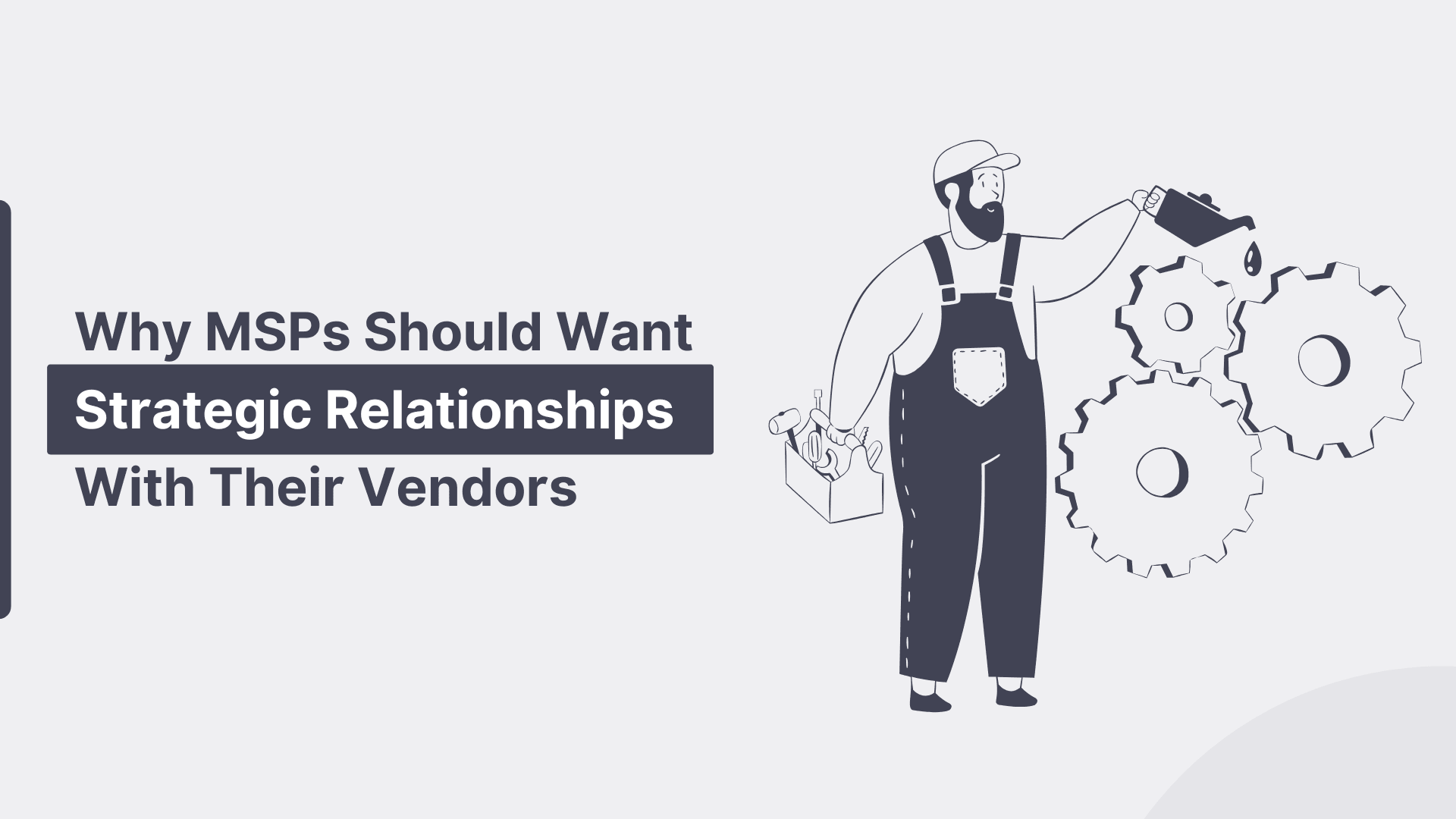Key Insights: How payment timing on both sides creates working capital advantages, and why vendor relationships are an untapped competitive edge.
“I’ve been to so many conferences lately, and all the MSPs are saying, ‘I wish my clients had a more strategic relationship with me. I want them to have a stronger relationship with me. I want to understand more about what they’re doing so I can help them more.'”
This observation from Monica Ozaruk, ConnectWise consultant specializing in procurement optimization and founder of MOZARUK Consulting, cuts straight to a fascinating irony in the MSP industry. After spending five years working with MSPs across North America and Europe on their procurement strategies, she’s identified a blind spot that’s costing many MSPs significant competitive advantage.
“But here’s what I’ve never heard at those same conferences,” Monica continues, “MSPs asking how to build strategic relationships with their own vendors.”
The parallel is striking. While MSPs invest heavily in client relationship management systems, vendor relationship strategy often remains unexplored territory. This creates a massive missed opportunity.
Think about this: MSPs who optimize relationships with both clients and vendors create sustainable competitive advantages that compound over time. These relationships improve cash flow and profitability in ways that most competitors never consider.
Where Your MSP Stands on Procurement Maturity
Understanding where your organization currently operates helps identify the specific opportunities for optimization. Based on Monica’s work with hundreds of MSPs, most organizations fall into one of three categories:
Reactive Procurement
This is characterized by ad-hoc purchasing decisions made by multiple team members without centralized management or strategy.
- No centralized vendor relationship management
- Payment terms accepted as given rather than negotiated
- Cash flow planning limited to 30-60 days
- Vendor relationships focused solely on immediate pricing with no strategic approach
- Purchasing decisions based on inventory needs, lowest price, or delivery speed with priorities varying wildly case-by-case
- Multiple people making purchasing decisions without coordination
Organized Procurement
These MSPs have centralized purchasing through designated team members, typically emerging around 15-employee teams.
- Basic vendor management and preferred supplier relationships
- Some payment term awareness but limited negotiation
- Quarterly cash flow planning
- Vendor relationships include service considerations beyond pricing
- Designated procurement responsibilities
Strategic Procurement
The most sophisticated approach includes dedicated procurement function, often full-time at 20-25 employees.
- Data-driven vendor partnerships with strategic planning conversations
- Negotiated payment terms aligned with cash flow optimization
- 12+ month cash flow forecasting and strategic planning
- Vendor relationships positioned as competitive advantages
- Systematic vendor performance and relationship management
The evolution isn’t about criticism—it’s recognizing that business growth naturally demands more sophisticated approaches to vendor relationships. Just like it does with client relationships.

How to Analyze Your Current Vendor Relationships
Monica Ozaruk’s work with MSPs has revealed a fundamental principle: “You can’t negotiate what you don’t track.” Makes sense, right? The most successful vendor relationship transformations begin with understanding exactly what you’re currently purchasing and from whom.
Monica’s approach starts with identifying your top five vendors by both volume and strategic importance. This isn’t just about total spending—it’s about understanding which vendor relationships create the most significant impact on your service delivery and cash flow.
Here’s what usually happens. The historical purchase analysis reveals surprising patterns. Monica worked with one client who was buying the same network switches for multiple client installations from the same distributor over several months. When they finally analyzed their purchase data, they realized something obvious in hindsight: they’d never asked for volume pricing despite being one of the distributor’s larger customers.
“We actually buy so much from you,” they told their vendor. “Could we go up a tier? Could we get some discounts?”
The answer was yes. They just had to ask.
Growth forecasting conversations with key vendors transform these relationships from transactional to strategic. When you can show a vendor that you’ve had 10% growth this year and forecast 20% growth next year for specific product categories, you’re no longer just another customer. You’re a growth partner worth investing in.
Monica’s detailed approaches to PSA system configuration for strategic purchasing—including ConnectWise procurement modules and vendor invoice matching—are available through her comprehensive walkthroughs. This ensures MSPs can implement these frameworks within their existing technology stacks.
How to Negotiate Better Terms with Your Vendors
The negotiation strategies that create working capital advantages go far beyond simple price discussions. Monica’s framework for vendor relationship optimization recognizes that the most valuable negotiations often focus on terms, timing, and strategic alignment rather than just unit costs.
Payment terms negotiation follows a systematic approach. Starting with your largest vendors, the conversation moves through a predictable progression: 30-day terms (often the default), 45-day terms (reasonable for established relationships), and 60-day terms (available for strategic partnerships with volume commitments).
Volume commitments create tier advancement opportunities that many MSPs never explore. Monica’s client with the switch purchasing scenario discovered that showing their historical buying patterns—and committing to forecast volumes—moved them up an entire pricing tier with their primary distributor.
Think about strategic timing of purchases. Rather than reactive purchasing when immediate needs arise, strategic MSPs plan purchases around payment collection cycles and cash flow forecasting.
MOZARUK’s approach to chart of accounts mapping ensures that procurement decisions integrate seamlessly with financial reporting. When you can clearly see which vendor relationships contribute most to profitability, negotiation priorities become obvious.
Here’s a real example of why this matters. The Microsoft licensing scenario Monica encountered illustrates why centralized procurement prevents revenue leakage. A technical team member added five licenses to a client account through a vendor portal but never notified finance. Six months later, the MSP discovered they’d been paying for licenses that were never added to client agreements—lost revenue that could have been prevented with proper procurement processes.
These licenses might only cost $10-50 each monthly, so we’re talking about $50-250 per month. But here’s the problem: this probably wasn’t the only time it happened. When simple miscommunications like this compound across multiple products and vendors, small leaks become expensive problems.

Why Fast Client Payments Enable Better Vendor Negotiations
Strategic vendor negotiations require predictable cash flow forecasting. You can’t negotiate 45-day vendor terms if you’re uncertain when client payments will arrive. This is where payment automation creates a competitive multiplier effect.
Alternative Payments’ automation advantage transforms payment timing from a variable to a constant. With an average payment time of 5 days compared to the industry standard of 30 days, MSPs gain the cash flow predictability that enables strategic vendor planning.
The customer transformation stories demonstrate this:
S1 Technology went from 15% client adoption in month one to 90% adoption of automated payments. This eliminated the variability that made vendor planning difficult and reduced their collection cycle from a full month to within 10 days of invoicing.
TeamLogic IT achieved 40% of receivables collected within the first few days of their billing period. That creates predictable cash flow for vendor relationship planning.
Triada Networks cut their payment cycle in half. Moving from 50-60 days down to below 30 days. This enabled more aggressive vendor term negotiations.
Alternative Payments integrates with 14+ PSA platforms including ConnectWise, Halo, SuperOps, and AutoTask. This creates seamless cash flow predictability because payment collection becomes automated and reliable.
When MSPs understand their cash conversion cycle, vendor conversations can focus on strategic partnerships and payment terms rather than unpredictable cash flow management.
Here’s the thing about payment timing certainty. MSPs operating with unpredictable 15-45 day payment cycles can’t confidently commit to volume purchases or negotiate extended payment terms.
Strategic MSPs with 5-day payment predictability can.
Strategic Implementation: The Right Order Matters
Rather than overwhelming your team with simultaneous changes, strategic implementation follows a logical sequence that builds momentum.
Step 1: Understand What You’re Actually Buying
Start with Monica’s vendor analysis approach. Identify your top five vendors by volume and strategic importance. Analyze your purchase history to understand patterns, frequency, and total spending by vendor. This data becomes your negotiation foundation.
Step 2: Negotiate Volume Pricing and Strategic Partnerships
Armed with purchase data, approach your largest vendors for volume pricing discussions. Show them your historical patterns and growth forecasts. Many MSPs discover they qualify for better pricing tiers simply by asking.
Step 3: Optimize Payment Collection Timing
Implement payment automation to create predictable cash flow. When you can forecast exactly when client payments arrive, vendor payment term negotiations become much easier to plan and execute.
Step 4: Negotiate Extended Vendor Payment Terms
With predictable incoming cash flow, negotiate 45-60 day payment terms with strategic vendors. You’re no longer guessing when you can pay—you’re planning strategically.
Step 5: Create the Working Capital Advantage
The combination creates a powerful competitive advantage: 5-day client collection + 45-day vendor terms = 40 days of working capital that competitors don’t have.

Why This Creates Lasting Competitive Advantages
The working capital advantages from optimized payment timing create sustainable competitive benefits that compound over time.
When you can collect from clients in 5 days while paying vendors on 45-day terms, you’re operating with a 40-day working capital advantage that enables strategic investments and competitive positioning that cash-constrained competitors simply cannot match.
This positioning becomes self-reinforcing: better cash flow enables better vendor terms, which creates cost advantages and strategic partnerships that result in better client solutions and service delivery.
MSPs implementing both vendor relationship optimization and payment acceleration report enhanced vendor relationships, better client service delivery, reduced operational overhead, and strategic positioning advantages that create sustainable competitive advantages.
Ready to optimize both sides of your vendor and client relationships?
Monica Ozaruk’s procurement optimization expertise at MOZARUK Consulting helps MSPs transform vendor relationships into competitive advantages through strategic frameworks and ConnectWise system optimization.
Alternative Payments provides the payment automation that creates cash flow predictability essential for strategic vendor negotiations. Schedule a cash flow optimization demo to discover how 5-day average payment collection enables the vendor relationship strategies that create lasting competitive advantages.
The working capital advantage isn’t just about better financial management—it’s about building sustainable competitive positioning through strategic relationship optimization.

